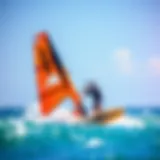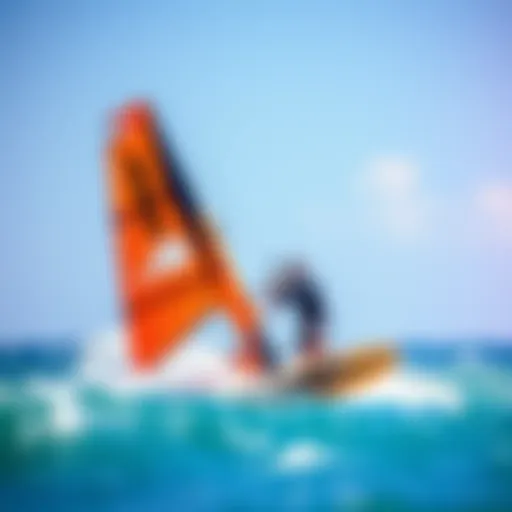Exploring Fone Kites: A Comprehensive Overview


Intro
Kiteboarding has gained a fervent following over the years, captivating both thrill-seekers and those looking to enjoy the serene beauty of the water. Among the top brands in this exhilarating sport is Fone, renowned for its innovation and quality. In this article, we will dive headfirst into the world of Fone kites. By examining their design philosophies and the cutting-edge technology that defines their performance, our aim is to shed light on what truly sets these kites apart from the competition.
Fone kites have found their way into the hands of riders at various skill levels, each with unique needs and preferences. Whether you’re a budding kiteboarder just starting out or a seasoned veteran ready to try your next big aerial move, understanding the intricacies of Fone kites can significantly enhance your kiteboarding experience.
The discussions here will range from essential techniques that can help novices find their footing, to tips and tricks that seasoned riders can incorporate into their repertoire. We will also conduct comprehensive equipment reviews—breaking down different kite models and boards, exploring their features, and highlighting user experiences. This journey will not only be informative but also practical, ensuring that all riders, no matter their expertise, can make the most of their kiteboarding adventures.
With proper techniques and equipment know-how, every kiteboarder can elevate their skills and make the most out of the conditions they face out on the water. So, without any further ado, let’s leap into the heart of the matter.
Techniques for Kiteboarding Enthusiasts
As the saying goes, you gotta walk before you can run. For kiteboarding, this translates into mastering fundamental techniques before attempting complicated maneuvers. Let’s break this down.
Beginner Techniques
For those just stepping onto the scene, the focus should be on establishing a solid foundation. Here are some essential techniques:
- Understanding Wind Patterns: Learning how wind interacts with your kite is critical. Spend time studying how different conditions affect lift and control. Wind direction can vary drastically, impacting your ride.
- Kite Control: Practicing how to control your kite on land is just as important as in the water. Try flying your kite on the beach to get a feel for the power zones— this will help later when you’re on the board.
- Starting from the Water: Master the basics of body dragging before attempting to stand on your board. This involves using the kite to pull you along the surface of the water. It helps to build confidence and control.
Advanced Maneuvers
Once you've got the basics under your belt, it’s time to turn your attention to more advanced techniques:
- Jumping Techniques: Timing is everything when attempting jumps. Focus on your approach speed and pop. A good jump starts with a strong edge.
- Transitions: Smooth transitions can significantly enhance your fluidity on the water. Practice switching directions without losing speed or power.
- Tricks and Stunts: For those willing to push their limits, learning tricks and stunts can elevate your kiteboarding experience. Start with simpler moves and work your way up to complex aerial maneuvers.
As you refine your skills, you will find that the joy of kiteboarding lies not only in the thrill of the ride but also in the mastery of the techniques that make it possible.
"Kiteboarding is like dancing in the wind, each move a step to complete the performance."
Equipment Reviews
The right equipment can make or break your kiteboarding experience. In this section, we’ll explore various kite models and boards, helping you make informed decisions based on your riding style and conditions.
Kite Reviews
Fone has several kite models designed for diverse conditions and rider preferences:
- Fone Breeze: Best for light wind conditions. This model is known for its stability and ease of use, making it an excellent choice for beginners.
- Fone Bandit: A versatile kite suitable for various riding styles. It offers great power and agility, preferred by many intermediate and advanced riders.
- Fone Phantom: Designed for high-performance and speed, this kite is fantastic for those chasing adrenaline in challenging conditions.
Board Reviews
The choice of board is equally vital. Here are some notable mentions:
- Fone Trax: Known for its lightweight design and responsiveness, this board works well in a variety of conditions.
- Fone Slice: A wave-oriented board that excels on the surf.
Prologue to Fone Kites
Fone kites have carved out a niche within the vibrant world of kiteboarding. These kites are known for their innovative designs and exceptional performance, a fusion that captures the hearts of enthusiasts across the globe. Understanding Fone kites is not merely an intellectual exercise; it offers practical insights for anyone looking to elevate their kiteboarding game. Their significance is underscored not just by the brand name but also by the technology and craftsmanship that drive these products.
Understanding Kiteboarding
Kiteboarding blends the thrill of surfing with the excitement of flying. It's a water sport that involves riding a board while being propelled by a power kite. The unique thrill lies in harnessing the wind to glide over water, jump high into the air, and perform tricks. Thus, the choice of equipment, notably the kite, plays a critical role in overall performance and enjoyment. Those diving into the world of kiteboarding quickly learn that selecting the right kite is akin to a painter picking the perfect brush. Proper equipment can mean the difference between soaring heights and crashing down hard.
Overview of Fone as a Brand
Fone isn't just another name in the crowded market of kiteboarding; it represents years of research, development, and practical use on the waters. Founded with a clear vision, the brand emphasizes innovation while paying close attention to user feedback. They manufacture a range of kites that cater to various skill levels and riding styles. From the beginner-friendly models to those designed for advanced riders, there's a Fone kite developed to meet a spectrum of needs.
Fone's commitment to quality is palpable. The company combines cutting-edge technology with insights drawn from seasoned riders, resulting in kites that are not only durable but also high-performing. They employ materials that withstand the rigors of the environment, ensuring longevity without sacrificing performance. This balance is crucial, especially when riders navigate the unpredictable nature of wind and water.
Design Philosophy of Fone Kites
When it comes to kiteboarding, the design philosophy underlying the kites has a substantial impact on performance and rider experience. Fone Kites is not just about making kites; it's about crafting a holistic experience that speaks to the needs of divers riders, from newbies dipping their toes in the water to seasoned pros mastering the skies. Understanding this philosophy sheds light on the meticulous attention to detail that drives Fone's kite development.
A well-thought-out design can make all the difference. It influences how the kite interacts with the wind, how easy it is to control, and even how the rider feels while cruising over the waves. With that in mind, Fone’s design philosophy prioritizes functionality, safety, and performance, allowing riders to leverage their skills effectively—whether they’re carving on flat water or catching massive air.
Material Selection and Construction
One of the cornerstone aspects of Fone's design philosophy is its choice of materials. The effectiveness of a kite starts here; the right materials can enhance durability, decrease weight, and improve overall performance. Fone invests substantially in high-end fabrics that resist tearing and fading from harsh sun exposure.
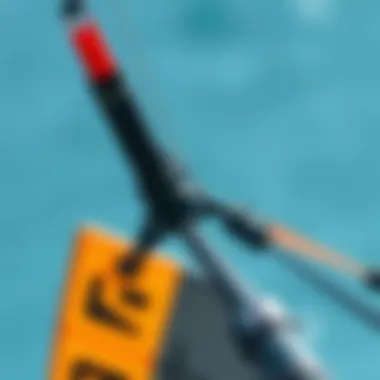
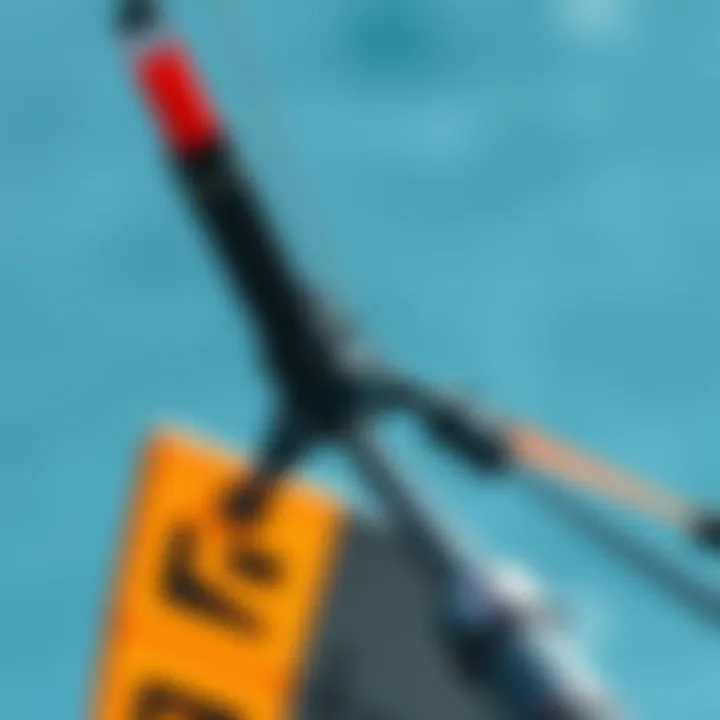
Benefits of Material Selection:
- Durability: The latest Dyneema and ripstop polyester are stitched with precision to withstand the rigors of kiteboarding.
- Lightweight: Advanced materials reduce the weight, which directly correlates with better lift and handling capabilities.
- Water Resistance: Many kites are treated to ensure water beads off rather than soaking in, which keeps the kite lightweight during performance.
Fone’s construction methods also take into account how various components work in harmony. From reinforced seams to strategically placed bladders, each kite serves a purpose. This meticulous construction process means riders can focus on their performance instead of worrying about their gear.
Aerodynamics and Shape
The design efficacy of Fone kites is further exemplified by their aerodynamics and shape. Analyzing the kite's profile offers significant insight into performance potential.
Key Considerations:
- Shape Variability: Fone designs a range of shapes suited to distinct riding styles. For instance, wider kites enhance lifting while narrower ones excel in speed.
- Canopy Design: The flat and cambered canopies offer varied power delivery. Flat canopies provide smoother flight, making them ideal for beginners, while cambered designs deliver explosive power for advanced riders seeking adrenaline.
Performance Implications:
- Lift: The aerodynamic profile is crucial; a well-designed kite generates lift effectively and promptly.
- Control: The shape contributes to how controllable the kite is in different wind conditions, which greatly enhances the rider's ability to adapt and execute maneuvers gracefully.
"A kite is not just a flying object; it's a finely tuned instrument that harmonizes with nature."
Thus, Fone's design philosophy encompasses not only technical specifications but also the subtle interplay of materials and aerodynamics. Riders equipped with Fone kites can appreciate how these intricacies enhance their kiteboarding experience, making each session more enjoyable and productive.
Performance Characteristics
When it comes to kiteboarding, the performance characteristics of your kite are what ultimately determines your experience on the water. This aspect is not just a box to check but a complex interplay of multiple factors that directly influences how a kite reacts in various conditions. Understanding these characteristics is essential, not only for making the right choice in equipment but also for enhancing your overall kiteboarding skills. With Fone Kites, riders can expect a sophisticated balance between responsiveness, stability, and power delivery that makes each session a memorable one.
Wind Range and Power Delivery
Fone Kites are designed to perform exceptionally well across a wide range of wind conditions, making them adaptable for various riding styles and levels. This adaptability is crucial, especially in kiteboarding where the wind can be unpredictable as a cat on a hot tin roof.
The wind range specified for each model serves as a guide to help riders determine when it's best to take to the water. For instance, the Fone Breeze is known for its impressive low-end power, allowing new riders to get up and flying even in lighter winds, while the more advanced Fone Bandit excels in harnessing higher winds effectively.
Power delivery is another vital characteristic that influences your ride. A swift responsiveness means that when you pull the bar, the kite reacts promptly, transferring power seamlessly. This can ultimately affect your ability to jump, turn, or even perform freestyle tricks. A deep dive into users' experiences reveals a preference for kites with consistent power delivery that does not drop suddenly, preventing unpleasant surprises while in the air.
Stability and Handling
"A smooth sea never made for a skilled sailor" – this saying rings true in kiteboarding. Stability is one of those aspects that might go unnoticed until a kite is rigged and in the air. Fone Kites are often praised for their stability, which comes from meticulous design and testing. Having a stable kite means that you can focus on your performance rather than battling the kite itself.
Handling is about how the kite feels when navigating through different directions, and Fone has engineered their kites to be intuitive. In choppy waters or strong gusts, riders report that Fone kites maintain control without jerky movements, which is especially beneficial when attempting tricky jumps or sudden turns. This stability affords riders the confidence they need to push their limits, whether they're just starting out or have been skimming the waves for years.
Jumping and Freestyle Capabilities
For those drawn to kiteboarding, jumping high and executing tricks can feel exhilarating – almost like defying gravity temporarily. Fone Kites have a reputation for being generous in terms of jumping capability. This is not only about height, but also about the predictability of the kite's behavior while airborne.
The designs emphasize a mix of lift and hang time, allowing riders to set themselves up for freestyle tricks. Many riders have shared their success stories, crediting the Fone Bandit for its launch height and responsiveness when executing spins or flips. The underside design allows for quick, snappy turns while in the air without sacrificing control, which is essential for steacing those “wow” moments during competitions or casual outings.
Riders using Fone Kites often report feeling more confident while attempting high jumps, attributing this sense of security to the kites' responsive handling and predictable landing.
In summary, the performance characteristics of Fone Kites demonstrate a thoughtful integration of wind range adaptability, stable handling, and excellent jumping capabilities. Each of these elements plays a pivotal role in ensuring that kiteboarders can not only navigate the waters effectively but also feel empowered to experiment and level up their skills. Understanding these factors allows riders to choose the right equipment that aligns with their style, skill level, and conditions they ride in.
Kite Models and Their Features
Understanding the various kite models offered by Fone is vital for those looking to optimize their kiteboarding experience. Each model is designed with specific features that cater to varied riding styles and conditions. By breaking down the unique benefits and considerations of each kite, riders can make more informed decisions based on their personal preferences or skill levels. This section will explore the details of notable Fone kite models—Breeze, Bandit, and Trax—highlighting what sets each apart while emphasizing their distinct functional aspects.
Fone Breeze
The Fone Breeze is an excellent choice for those just dipping their toes into the kiteboarding waters.
Features:
- User-friendly design: The Breeze stands out for its simple setup process and forgiving flight behavior. It allows beginners to focus on learning the basics without getting overwhelmed.
- Versatile performance: This kite adapts well to a variety of wind conditions, ensuring a comfortable ride under changing environments.
- Lightweight construction: Ideal for early morning or late afternoon sessions when the breeze is light, the lightweight materials used in the Breeze make it an optimal choice.
Benefits:
- Increased confidence for new riders as they master balance and control.
- Greater enjoyment during learning processes leads to a smoother transition into kiteboarding.
In summary, for learners wanting to get a taste of kiteboarding without any unnecessary complications, the Fone Breeze is a solid contender.
Fone Bandit
Stepping up in performance and agility, the Fone Bandit appeals to intermediate to advanced riders looking for a versatile kite that excels across various conditions.

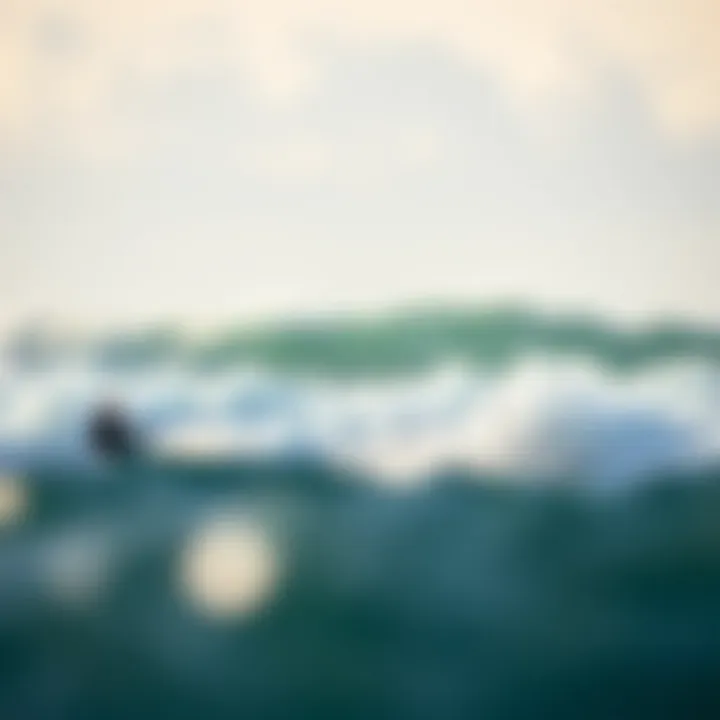
Features:
- Advanced aerodynamics: The Bandit is designed with a refined shape that provides better lift and driving power, which is crucial for executing tricks.
- Great stability: With its high aspect ratio and distribution of power, this kite maintains stability even when performing aggressive maneuvers.
- Responsive handling: Riders appreciate the precise control, allowing for sharp turns and rapid ascents with minimal effort.
Benefits:
- Enhanced capability to perform freestyle tricks with confidence, providing ample air time.
- Strong performance in both light and strong wind, maximizing versatility for any riding scenario.
The Bandit proves to be more than just a kite; it’s a reliable partner for those who embrace the thrills of more action-driven kiteboarding.
Fone Trax
For those who seek speed and power on the water, the Fone Trax is a prime candidate. This model caters to riders keen on embracing speed and carving through waves.
Features:
- Aggressive design: Built for performance, the Trax features a compact outline that promotes fast turns and rapid acceleration.
- Powerful upwind capabilities: This kite excels at moving upwind, allowing riders to cover more ground efficiently.
- Durable construction: Designed to endure the rigors of wave riding, the Trax utilizes reinforced materials to withstand intensive conditions.
Benefits:
- Greater speed and agility result in thrilling riding experiences on dynamic waters.
- Ideal for advanced kiteboarders who enjoy pushing limits and trading off stability for exhilarating performance.
In essence, the Fone Trax is engineered for those who are not just in it for a casual ride. It’s built for riders with a zest for the wind and water, intending to carve not just a path but a legacy on the waves.
"Choose your kite model wisely. It defines your connection with the water and shapes your entire ride experience."
By evaluating these features and benefits through the lens of personal skill and riding style, kiteboarders can pinpoint the model that resonates best with their aspirations.
User Experiences and Feedback
User experiences and feedback hold great significance in the context of Fone kites. They provide a window into the actual performance and suitability of these kites from the perspective of varying rider abilities.
When choosing a kite, potential buyers often look to the experiences of others to gauge aspects like reliability, ease of use, and versatility on the water. These insights can inform a rider's decision on which model might best suit their personal style or level of expertise.
The following sections detail specific reviews from beginners as well as insights from seasoned riders, clarifying how specific factors like user demographics, skill levels, and even personal preferences influence their feedback. This not only serves as an aid for prospective buyers but gives the manufacturer valuable information about product performance, helping them to make design improvements.
Reviews from Beginners
Beginners venturing into the world of kiteboarding often have a unique set of expectations and concerns. Many who purchase Fone kites highlight the intuitive design as a standout feature. For example, those who have just set foot on the sand often comment on how easy it is to get the kite flying without excessive fussing.
Standard feedback generally revolves around the following points:
- User-Friendly Setup: Many first-time kiteboarders appreciate how Fone kites come with clear assembly instructions. This clarity can relieve a lot of early stress for those just learning the ropes.
- Forgiveness in Design: Beginners tend to notice how forgiving these kites are during their learning curves. Riders often describe crash landings as less daunting because the kites tend to recover quickly, allowing them to maintain confidence while they gain skills.
- Stability in Various Conditions: A common point made by novices is that Fone kites provide stability in lower wind speeds, helping them to get up and riding sooner. This aspect helps alleviate the initial fear associated with kiteboarding, making the learning experience far more enjoyable.
Insights from Experienced Riders
As one progresses in the sport, the expectations from a kite evolve significantly. Experienced riders are often focused on performance characteristics, such as responsiveness and power delivery during tricks. According to seasoned users, Fone kites excel in various conditions, delivering reliability and performance that can push one’s skills further.
Insights from experienced kiteboarders generally highlight the following:
- Precision Control: Skilled riders often rave about the precision with which they can control Fone kites. This responsiveness is especially appreciated during high-speed maneuvers and tricky jumps.
- Durability Over Time: Another aspect that skilled users frequently commend is the durability of the materials used. After extensive use, many report minimal wear and tear, indicating that Fone kites can take a beating.
- Jumping and Freestyle Performance: A notable mention from veterans is how well Fone kites facilitate jumps and freestyle techniques. Many riders enjoy testing their limits and report that the structure of the kite allows for amazing hang-time and fluid transitions.
"Fone offers a unique balance between user comfort and high-performance, making them an exceptional choice for riders of all skill levels."
This amalgamation of beginner reviews and experienced insights presents a holistic view that can guide potential buyers confidently in their decision-making process. It’s often this real-life feedback that shapes aspirations and fuels further participation in the sport. For more discussions and first-hand accounts, you can visit Reddit or check out community reviews on platforms like Facebook or Kiteforum.
Maintenance and Care
Proper maintenance and care for Fone kites plays a crucial role in ensuring their longevity and optimal performance. Just as a well-tuned instrument produces the most beautiful melodies, a well-maintained kite delivers remarkable rides. Neglecting this aspect can lead to diminished performance, inefficiencies, and mean unwanted expenses for replacements or repairs. Hence, enhancing your skills while keeping your equipment in tip-top shape should go hand in hand.
Some key elements of maintenance include regular checks for damage, cleaning, and storing your equipment correctly. Each step not only prolongs the life of the kite but also elevates your overall experience on the water. A bit of vigilance can go a long way in avoiding the headache of unexpected failures on windy days.
"An ounce of prevention is worth a pound of cure.”
Routine Maintenance Practices
When it comes to routine maintenance, a few diligent practices can make a world of difference:
- Inspect the Bladder: Before each use, check for leaks. An easy way is to inflate the kite and listen closely; any unusual hissing might signal a puncture. If you do find one, it’s wise to patch it up before it leads to a catastrophic failure mid-ride.
- Clean the Kite Post-Use: Saltwater, sand, and dirt can accumulate on the kite fabric and valves, which can lead to deterioration. A simple rinse with fresh water after each session can keep it in good condition, preserving the material’s strength and integrity.
- Storage Considerations: When not in use, store your kite in a cool, dry place, away from direct sunlight. Avoid folding it in tight creases and instead roll it up. This will maintain the shape and prevent wear on the seams.
While these practices may seem basic, they serve as the backbone of any kiteboarder's maintenance routine.
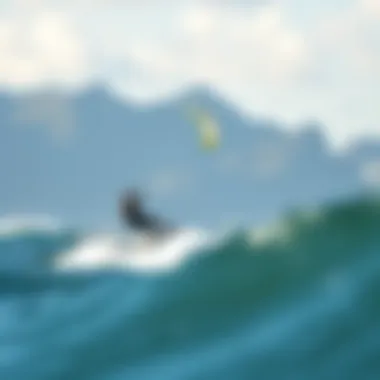
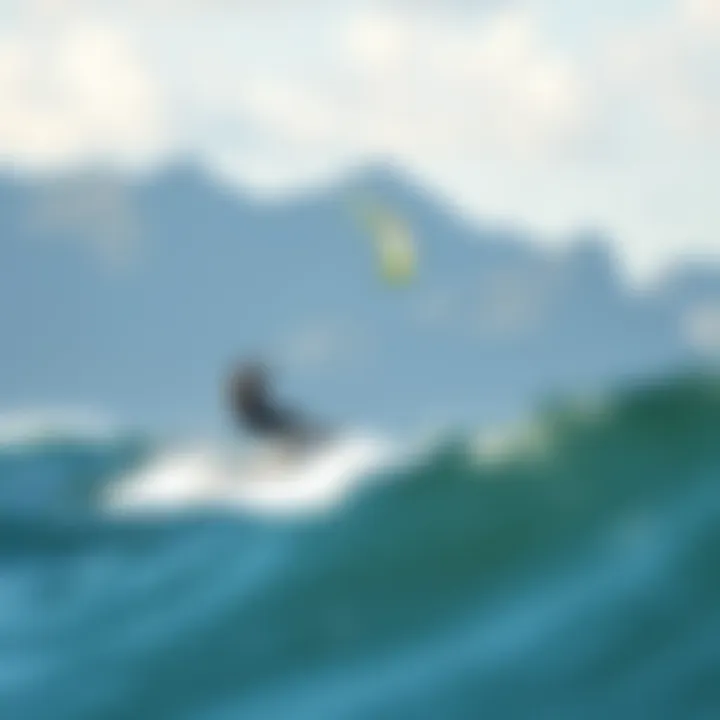
Repair Techniques and Tips
Despite your best efforts, sometimes accidents happen. When they do, knowing how to repair your kite can save you both time and money. Here are some techniques and tips to guide you through the process:
- Surface Repair: For small cuts or abrasions on the canopy, specific repair patches can be purchased. It’s essential to clean the area thoroughly before applying the adhesive patch. Ensure it's firmly set to avoid the patch coming loose during flight.
- Bladder Repairs: If you discover a leak in the bladder, drain it and use a repair kit specifically made for bladder repairs. These often include adhesive and patches that are compatible with the bladder material.
- Seek Professional Help: For significant damage or if you’re not confident in your repair skills, don’t hesitate to take your kite to a professional. While it may seem like an expense, a quality repair can extend the life of the kite considerably.
Learning to care for and repair your kite not only safeguards your investment but also gives you the confidence to ride harder without the fear of an unexpected malfunction. In the world of kiteboarding, knowledge is as valuable as skill on your board.
Troubleshooting Common Issues
Kiteboarding, much like any other sport, has its share of challenges. When it comes to equipment, understanding how to troubleshoot common issues can significantly enhance your overall experience on the water. Knowing what problems can arise, and how to tackle them, not only saves time but also ensures safety while kiteboarding. This section aims to arm kiteboarders—whether they are just starting out or have years of experience—with the tools to recognize potential problems and to address them efficiently.
Identifying Performance Problems
Performance issues with your Fone kite can stem from various factors, often making it feel less responsive or unstable. Here are some critical signs and symptoms to look for:
- Unresponsive Steering: If the kite isn’t steering as expected, it might indicate a problem with the lines or the control system.
- Fluctuating Power: An inconsistent pull could signal an issue with the kite’s shape or wind interaction. It’s crucial to check the leading edges and check for any deformities.
- Difficulty in Launching or Landing: If you’re struggling with these basic maneuvers, something might be off with the bridle setup or line tension.
- Excessive Flapping or Tumbling: If the kite appears to be excessively flapping or tumbling in the air, it might be due to incorrect inflation or issues related to the canopy or frame.
These signs are early indicators that something isn’t quite right with your kite. Riders should take note of these symptoms and approach them proactively, instead of waiting for a complete failure.
Solutions for Frequent Malfunctions
When it comes to solving performance problems, there are several practical solutions worth noting. Here’s a guideline for addressing the most frequent malfunctions:
- For Unresponsive Steering:
- For Fluctuating Power:
- For Trouble in Launching or Landing:
- For Excessive Flapping or Tumbling:
- Inspect the lines for tangles or wear. Ensure that they are correctly attached to the kite and control bar.
- Adjust the trim settings on the control bar to see if it alters the response.
- Examine the kite for any visible punctures or wear, especially along the seams. These can affect the kite’s lift capabilities.
- Adjust the angle of attack if possible. Sometimes, a small tweak can make a big difference.
- Make sure you are launching in clean wind away from obstacles and that your lines are without twists.
- Check the bridle setup and re-rig if necessary; the correct configuration is crucial for optimal performance.
- Ensure the kite is adequately inflated. Under-inflated kites will mishandle, causing instability.
- Look for any damage to the structure. Repairs such as patching small tears can restore airflow dynamics.
Repairing and maintaining your kite, understanding the nuances of its operation, and being prepared to troubleshoot common issues can make all the difference. Being proactive will not only get you back on the water quickly, but it will also enhance your overall riding experience and ensure safety.
"A well-maintained kite is a happy kite. Know your gear, keep it in shape—your rides will thank you."
By identifying these issues quickly and employing straightforward solutions, kiteboarders can continue to enjoy the sport without unnecessary interruptions. For more detailed troubleshooting tips and community insights, you might find useful resources like Reddit or Wikipedia helpful. Understanding your kite and its intricacies is vital, so when in doubt, consult with fellow riders or professionals.
Kiteboarding Locations Favorable for Fone Kites
Identifying suitable locations for kiteboarding is crucial for any rider looking to maximize their experience on the water. Fone kites, with their unique design and performance characteristics, thrive in specific conditions that can enhance their capabilities and provide a more enjoyable ride. The importance of understanding the environment where these kites perform best cannot be overstated. This section delves into various kiteboarding locations that cater to both beginners and advanced riders, ensuring that every user finds the perfect spot to practice their skills and enjoy the thrill of the sport.
Top Spots for Beginners
For those just dipping their toes into the sport, choosing a beginner-friendly spot is vital. Here are a few locations that are particularly welcoming to novices:
- Hood River, Oregon: Known as the kiteboarding capital of the United States, Hood River offers steady winds and smooth water, ideal for learning. The local community is supportive and includes several schools to help newcomers get started safely.
- San Diego, California: With its beautiful beaches and consistent winds, San Diego provides ample opportunities for beginners. The shallow waters near the shore allow new riders to practice without the fear of deep water.
- Turtle Bay Resort, Hawaii: This location combines stunning scenery with calm conditions, perfect for starting out. The gentle trade winds and warm water make it easy for learners to get comfortable with their kites.
Key Takeaways for Beginners:
- Ideal locations should offer consistent winds without extreme gusts.
- Shallow waters are preferable to mitigate the risks involved.
- Access to lessons and experienced instructors is beneficial for newcomers.
Challenging Locations for Advanced Riders
Once kiteboarders gain confidence and skill, they might seek more challenging environments to test their limits. Here are some prime spots that promise excitement:
- Tarifa, Spain: Known for its infamous winds, Tarifa is a mecca for advanced riders. The location's strong gusts and challenging currents make it an adventure-packed destination that tests a rider's skills to the fullest.
- Cape Town, South Africa: With the majestic Table Mountain as a backdrop, Cape Town offers thrilling conditions. The infamous "Cape Doctor" wind brings strong, consistent blows that favor experienced riders looking for adrenaline-pumping sessions.
- Cumbuco, Brazil: This region combines flat waters and downwind runs, creating a paradise for advanced riders. The local conditions encourage high jumps and tricks, making it a favored destination for freestyle enthusiasts.
Things to Consider for Advanced Riders:
- Varying wind conditions are essential to challenge one's abilities.
- Awareness of hazards, such as currents and obstacles, is vital.
- Engaging with local riders can provide valuable insights and safety tips.
"Choosing the right spot can make or break your kiteboarding experience. Knowing your environment allows you to truly harness the power of your Fone kite, whether you're just starting out or pushing the limits."
The End
Bringing all the pieces together, the section on conclusion serves as a vital element in this exhaustive exploration of Fone Kites. It’s not just a summation; it's a moment to reflect on the importance of understanding the nuanced aspects of these kites. This article has aimed to shine a light on various key elements that contribute to the kiteboarding experience—design philosophy, performance characteristics, user feedback, and maintenance practices.
Summarizing Key Insights on Fone Kites
- Design Philosophy and Construction: The materials and shapes of Fone kites are meticulously crafted to enhance performance, stability, and responsiveness in various wind conditions. A kite's construction directly impacts its durability and flexibility.
- User Experiences: Feedback from both novices and experienced riders is invaluable. Fresh enthusiasts often appreciate kites that offer easier handling, while seasoned riders tend to look for agility and customization. Their insights can guide potential buyers on what to expect from different models.
- Maintenance Practices: Regular upkeep of kites cannot be overstated. This article discussed necessary routine checks and repairs, underlining how minor issues, if neglected, could lead to significant problems down the line. Keeping your equipment in top shape enhances safety and performance.
- Challenging and Exciting Locations: Understanding where to ride not only heightens the fun but also elevates the skill level. Each location presents unique conditions that can either make or break your kiteboarding experience. Knowing your surroundings is essential for maximizing performance and enjoyment.
Reflecting on these aspects arms kiteboarders of all levels with better insight into Fone kites and kiteboarding as a whole. Whether you’re just getting your feet wet or are gearing up for a high-flying adventure, the key takeaway remains substance over flash—understanding how gear, technique, and environment interact can make all the difference.
For further insights or discussions in the kiteboarding community, consider checking out resources such as KiteForum, Reddit's Kiteboarding Subreddit, or local clubs and meet-ups that can add value to your learning journey.










